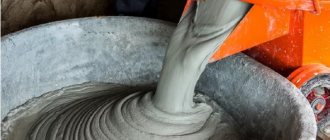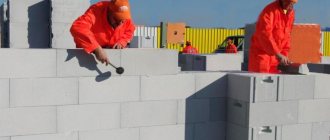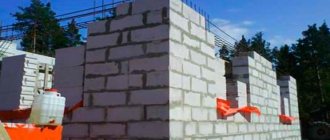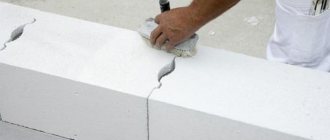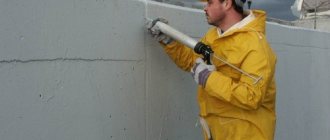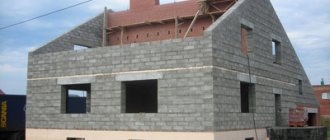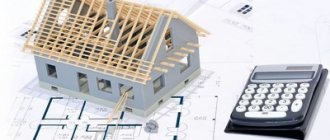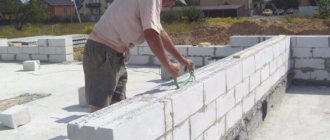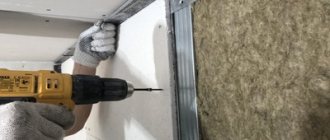Mortar consumption when laying expanded clay blocks
The consumption of mortar when laying expanded clay blocks is quite important. After all, there are cavities here and therefore its consumption increases.
In turn, the construction price will be higher. But you need to know that if you prepare it correctly, the consumption of the mortar per 1 m3 of masonry of expanded clay concrete blocks will be lower, and then you can save on this and make the masonry high-quality. Moreover, you can do it yourself and without outside help.
Solution and its consumption per 1 m3
The stability, sound insulation, safety and reliability of expanded clay concrete masonry directly depends on the quality of the prepared mortar.
Sand-cement and adhesive compositions are popular. The creation of cement mortar is carried out on the basis of cement powder, water and sand. The use of clay is acceptable, but not preferred. It contributes to the deterioration of the strength characteristics of the mixture. The best option is river sand. To ensure that the cement mortar does not lose its technical and operational parameters, it must be stirred regularly, preventing it from working.
Important! The moisture content of the sand must be taken into account. The volume of liquid in the solution will depend on this. Achieving the required consistency for masonry is achieved using a concrete mixer or an electric drill with a special “mixer” attachment.
Average calculations show that per 1 cubic meter of expanded clay concrete blocks there is 0.2 m3 of cement composition. Approximately 1.5 bags of cement powder and 4.5 bags of river sand will be required. The recommended ratio is 1 to 3, cement and sand respectively. When preparing the mixture, you should read the instructions provided by the manufacturer of the cement composition.
Which composition to choose?
When constructing load-bearing structures using ceramic stone, a special connecting mixture is used. It differs from CPR in its minimal thermal conductivity and is more plastic when applied. The composition is saturated with additional low-density components. What kind of solutions are used for ceramic blocks:
- A dry, finely dispersed mixture prepared on special equipment based on expanded clay chips and perlite.
Additionally, frost-resistant plasticizers are added to it, giving the material flexibility and retaining moisture.The powder just needs to be diluted with water in the ratio indicated on the package.
- The solution is prepared with your own hands. To create, crushed perlite and cement are used in a ratio of 1:3. To maintain flexibility and mobility, plasticizers are added to the mixture. The solution is mixed with a concrete mixer, which breaks up the lumps. They form quickly due to the properties of perlite.
- The most common cement-sand mortar made from Portland cement, the only advantage of which is its low cost.
Advantages of a special connecting mixture for laying ceramic stone:
- Light weight of the finished substance, the overall load on the foundation is lower.
- Together with ceramic blocks, excellent sound insulation is created, a high level of sound absorption, sounds from the street do not penetrate the walls.
- Increased level of indoor comfort, absence of cold bridges.
- Low consumption of material due to its plasticity, saving money and time for mixing, reducing the time for laying.
- Fire resistance, thanks to which the composition can withstand prolonged heating and does not ignite.
- Decorative properties, the ability to make joints for jointing and make the wall surface part of the finish.
- The price for the mixture is affordable.
There are no disadvantages to the ready-made solution for ceramic blocks, since it was created specifically for this material and matches its properties as closely as possible.
Methods for laying expanded clay concrete blocks
The choice of method for laying expanded clay blocks depends on many factors: the construction project, climatic conditions, the wishes of the customer, the capabilities of the construction team, and others.
There are different types of masonry:
- Half a block away. Used for laying expanded clay concrete structures of small thickness. Similar to block width. Additional thermal insulation with polystyrene foam or other material is assumed;
Half a block
- To the block. A popular option, characterized by the cost-effectiveness of the masonry process. Bandaging of external and internal wall structures is provided. The thermal insulation of the building is almost doubled.
To the block
- Kolodtsevaya. A distinctive feature is the construction of two wall structures. Connecting bridges are made between the internal and external walls. The resulting so-called “wells” are filled with insulating material;
Kolodtsevaya
- One and a half blocks. The stones are laid using the poke and spoon methods. Bandaging the wall is ensured by alternating methods for each subsequent row.
One and a half blocks
Preparation of the solution
Masonry can be done using a mortar of sand and cement or using a ready-made mortar.
Consumption of mortar for masonry photo
- The masonry mixture is made from sand, cement and water, in the following proportions: 3 parts sand, 1 part cement, 0.7 parts water. In this case, the grade of cement must be no lower than M400.
- Part of the water is added depending on the moisture content of the sand and the consistency of the solution, which may vary depending on the material being laid and the ambient temperature. For this purpose, water is added last and in small portions. By the way, a properly prepared solution is first mixed dry without water, and only then water is added.
- For expanded clay concrete blocks, you should prepare not a liquid solution, but a somewhat steep one, but having a certain plasticity. This is due to the fact that concrete-based materials do not absorb moisture well and an incorrectly prepared solution will leak out of the joints.
- To give the mortar the required characteristics that make the mortar convenient for laying, quarry sand can be added to river sand, which may contain a small amount of clay, making the mortar more plastic. A more plastic solution can be obtained without reducing its basic characteristics by adding various plasticizers to the solution.
- If it is not possible to bring sand and cement, and there is no container for preparing the solution, then you can purchase a ready-made mixture in dry form, to which you just need to add water and stir. Such mixtures have good plasticity and are capable of producing joints with a thickness of 3-5 mm, while cement mortar with sand produces joints of 6-9 mm. You can immediately say that the finished mixture will cost half as much, but still, it will not be cheaper.
- To prepare a high-quality solution and in the required quantity, you should get a concrete mixer or find a trough. It is only desirable that there are no stiffening ribs along the edges.
- This is especially true when construction is carried out from scratch and a lot of cement mortar will be needed. Do not mix a large amount of solution at once. It should be prepared as much as can be used within 1-2 hours of operation. When mixing in a concrete mixer, you should not keep the solution in it until it is completely used up, but you should immediately throw it out of the concrete mixer into some container and immediately rinse the concrete mixer.
- If the solution is not used quickly, it begins to separate: sand and cement settle to the bottom of the container, and water rises to the top. To ensure that the solution is always homogeneous, it must be stirred from time to time.
- Ready-made dry mixtures are not prepared in a concrete mixer. To prepare them, all you need is a container and a drill with an attachment.
- It should be noted that the technology for preparing the solution manually is somewhat different from the technique for preparing the solution in a concrete mixer. Here, the operations have the opposite sequence: if you first need to manually stir the solution in a dry form, and then add water, then when preparing it with a concrete mixer, water is first poured into it, cement is added, and sand is added only last. All this happens during constant operation of the concrete mixer. In other words, the consistency of the solution is controlled by the amount of sand, although you can add water at the end.
Attention: The more cement you add to the mixture, the stronger it will be when dry. At the same time, the consumption of mortar for masonry made of expanded clay blocks will remain the same
The technology for laying such blocks does not have any special features, and anyone who wants to do it with their own hands can do it.
Technological process
Algorithm for performing the work:
- Calculations of the load of the capital structure are carried out. The amount of required construction raw materials is calculated. Design documentation and work flow diagram are created. Coordination is being carried out in municipal structures. Obtain the necessary permissions to connect communications.
- Preparatory work. The area is cleared of trees, bushes, and construction debris. The ground base is leveled, the top, fertile layer of soil is removed. Markings are being made for the future building.
- The foundation structure is being erected. The reliability of the entire structure depends on the correct calculation of the foundation.
- The foundation is waterproofed, protecting it from the negative effects of moisture and groundwater.
- The masonry of expanded clay concrete walls, partitions, lintels, and the construction of openings for doors and windows are carried out. The reinforcing concrete belt is poured.
- They begin to implement the rafter system. The roofing cake is being assembled. Provides surface waterproofing.
- Exterior decorative finishing. This also includes thermal insulation of walls, which allows you to retain heat inside the house.
Creation of masonry mortar
Not the usual sand is used, but perlite or expanded clay. The main raw material is cement powder grade M-300 or M-400. To achieve the required consistency, use a concrete mixer or drill with a “mixer” attachment. The ratios of ingredients do not differ from mixing a standard sand-cement mortar. For 30 liters of water there are 20 kg of cement.
Important! Before use, it is recommended to moisten the block material with water to prevent moisture from being absorbed from the solution. The solution sets evenly. The wall does not dry out. The technological process is not disrupted.
The mortar is laid in a continuous, uniform layer. Special attention is paid to the procedure for joining adjacent blocks. The combination of the ridges is carried out on the weight of one element with the already laid one. The block is lowered along the guides onto a horizontal layer. Installed in place with light blows of a rubber hammer.
Choosing a foundation
The choice of the type of foundation structure depends on the availability of groundwater and the geological characteristics of the soil. Designs such as:
- bored pile elements with the construction of a concrete grillage;
- strip (shallow or buried) foundation;
- slab structure;
- FBS elements.
Bored-type piles are resistant to displacement of subsidence and sandy soil. The strip version in any design is the simplest and lightest type of foundation used for homogeneous, stable soil. Slab construction is popular. A properly constructed monolith will not shrink or crack. A strong foundation is provided for a permanent structure. All options are suitable for the construction of an expanded clay concrete structure. The choice depends on the nature of the construction site, climatic conditions, and the financial capabilities of the customer.
Important! When constructing the foundation of a house, special attention is paid to waterproofing the structure. It is important to exclude the possibility of moisture penetration. You can use ordinary roofing felt or mastic. A 2-layer device is recommended.
First order
It is important to start the construction of an expanded clay concrete wall correctly so that problems do not arise in the future. It is mandatory to check the evenness of the installation using a building level.
Installation of expanded clay concrete products begins from the corner of the future building. A cord is stretched between the corners to ensure evenness of the masonry order. The mallet allows you to achieve the recommended density of laying the building material. Subsequent rows are laid identically.
Important! The block is laid with voids downwards.
First row
Reinforcement of expanded clay concrete masonry and armored belt
The reinforcement process ensures the strengthening of the capital structure. Every 4-5 rows, a metal reinforcing mesh with a rod thickness of at least 5 mm is laid.
Reinforcement
The peculiarity of the reinforcing belt is to ensure a uniform load on the expanded clay concrete blocks. Its filling is carried out at the construction site. Wooden formwork is being installed. A metal frame is knitted. The concrete solution is being poured. The reinforcing frame provides strength, and the wooden formwork fixes the boundaries of the structure. The technology for constructing an armored belt involves the use of solid bricks.
Masonry of internal walls
The height of the construction of the internal wall is within 3.5 m. The construction of partitions from expanded clay blocks requires reinforcement with cores or a monolithic belt.
Bandaging of internal and external walls
Bandaging is carried out with anchors or using a metal mesh. It is inserted into the wall at the level of horizontal seam joints. The laying interval is 0.6 m. Metal elements in the form of brackets are preferably chosen from stainless steel. It is important to prevent the development of corrosion and damage to parts during operation.
Dressing
Masonry wall pie
Achieving maximum conservation of thermal energy inside an expanded clay concrete house is achieved by constructing two- or three-layer walls. The wall pie can be presented in the form of expanded clay concrete blocks, insulation material, and external facade cladding. In the latter case, decorative plaster or facing bricks are actively used.
Important! Creating a ventilation gap between the heat-insulating building material and the cladding helps evaporate excess moisture during the warm season.
Pie
Laying openings, installing lintels
The instructions assume the construction of special reinforcement lintels over all openings. They are presented in the form of metal corners or other profiled material. It is allowed to use ready-made reinforced concrete lintels.
Installation of openings
How and how to cut expanded clay block
It is recommended to cut blocks with a tool such as an alligator saw. A huge range of products is presented. The most durable and high-quality block will be cut accurately and evenly.
If you don’t have such a specialized tool, you can use a grinder. But you will additionally have to use an angle grinder. The radius of the disk is limited. Cuts are made along the perimeter to the maximum depth. Then the block breaks. The corners are sanded.
Important! For large-scale construction, it is worth using a saw. Bulgarian - construction crisis. It will take a lot of time and effort.
Mounting the Mauerlat
Several options are expected.
In the first case, wooden beams are used. There is additional reinforcement of the structure with metal brackets. Their fixation is carried out several orders of magnitude lower than expanded clay blocks.
In the second case, ordinary boards are used. They are formed in two rows. The first one is mounted on top of an expanded clay concrete layer. For reliability, it is fixed with anchors. After laying the second row, dressing is performed. The boards are connected to each other using large nails.
Mauerlat
Wood, as a building material, is subject to rot and mold due to high humidity and direct exposure to water. It is recommended to install waterproofing material to protect the surface. The best option is roofing felt.
Cement consumption
Usually, when constructing private houses, builders use cement-sand mixtures. And the main component in them is cement. Moreover, it is also the most expensive. Therefore, in order to save money again, you need to know the consumption of cement per cubic meter of brick laying.
Firstly, there is a dependence on the brand of cement that it was decided to add to the masonry mortar. Usually this is either M300 or M400. The first will have to be added in larger quantities than the second. But the second is more expensive than the first. So this indicator has little effect on saving money.
Secondly, the brand of the solution itself. The lower it is, the less cement is required. For example, there is a classic solution, which is determined by the ratio of binder to sand as 1:3. That is, to make such a mixture, one part of cement and three parts of filler are required.
Masters do this in different ways, most often using buckets. Because the specific gravity of the two materials is the same and equal to 1400 kg/m³. That is, one ten-liter bucket is filled with 14 kg of material. If you count it into bags of cement, which is 50 kg, then one bag fits 3.5 buckets. Based on this, you can accurately calculate the required number of bags.
Cement consumption for different types of mixtures Source greenbuilding.rf
There is another way. Here, the calculation of cement consumption for masonry is based on the volume of each material. To do this, take one cube of sand as the main ingredient. And the required volume of cement is calculated: 1:3 = 0.333 m³. In liters it will be 333. Or 33 buckets.
Now about the consumption of cement and mortar in general. As mentioned above, for laying 1 m³ of wall, where ordinary solid stone is used, 0.221 m³ of solution is required. And if a mixture of the classic ratio of 1:3 was used for this, then cement was added to it: 0.221:4 = 0.055 m³. Let's convert the figure into kilograms: 0.055x1400=77.
The video shows the proportions of cement for masonry mortars:
Masonry in winter
The technology for laying expanded clay concrete blocks in winter is not much different from summer. The sequence of work is similar, but some additional introductions are required. The complexity of the process increases. You need to prepare for additional costs for electrical energy and specialized adhesive composition.
In winter, construction compounds freeze quickly. Waiting for the water to heat up. A specialized solution with anti-frost components is used to prevent the blocks from icing during the construction process.
What kind of mixture is needed?
For laying expanded clay concrete blocks, only durable cement mortar is used. For its production, Portland cement of a grade not lower than M400 is used. This is a finely ground powder consisting of clinker and gypsum. He has won the trust of consumers, since in many cases he is simply irreplaceable.
Advantages of the cement composition for laying expanded clay blocks:
- High compressive strength. This means that even if cracks appear and the building deforms, the mixture does not collapse or crumble.
- Rapid hardening and onset of setting.
- Resistance to mechanical stress, moisture, corrosion.
- Minimal shrinkage.
- High elasticity.
- Frost resistance. If the proportions and construction technologies are observed, the solution does not lead to the appearance of “cold bridges”.
- Affordable price.
- Can be used for expanded clay concrete blocks with uneven surfaces and chips.
Disadvantages of cement mixture:
- Lack of use during the cold season.
- The need to purchase or rent a concrete mixer.
- Short shelf life. The finished composition must be used within 2 hours. When opened, even dry cement can be stored for no more than 45 days.
Possible mistakes when laying yourself
Let's look at the most popular mistakes to avoid them:
- Purchase of low-quality construction raw materials. It is recommended to use factory products produced in compliance with manufacturing technology. Special tests and quality checks of manufactured products are mandatory. If there is an error, the entire batch may be rejected.
- Use of bricks of limited density. It is recommended to use material with a density of at least 800 kg/m3 for residential buildings. For non-residential and utility buildings, a block with a density of 600 kg/m3 is suitable.
- Laying reinforced concrete slabs on walls. It is required to construct a reinforcing belt that evenly distributes the load on expanded clay concrete products from the upper floors.
- Thin joints of masonry composition. Recommended thickness is 10-15 mm. It all depends on the purpose of the capital structure. Experts advise using information from building regulations.
- Application of chipped expanded clay concrete products. This reduces the strength and reliability of the constructed walls. Dangerous for residents of the house.
Expanded clay blocks will allow you to build a permanent structure as quickly and reliably as possible. It is recommended to study the technological process and use only certified raw materials. It is important to follow safe work practices and use personal protective equipment. Your life and health are only in your hands.
What does the material contain?
The composition of the adhesive for expanded clay concrete blocks includes the following components:
- Portland cement. It acts as the main binding agent.
- Sand. To produce high-quality glue, fractionated sand that has undergone purification is used. It is necessary to give the mass plasticity. When there is a temperature difference, it is the sand that prevents the wall from cracking.
- Polymers. They are needed to fill chips and unevenness on the blocks. Thanks to polymers, the adhesion of the adhesive to the surface increases.
- Modifiers. They prevent the formation of cracks in the adhesive base and prevent heat from leaving the room.
How to cook it correctly?
In order for the glue to fully exhibit its adhesive properties, it must be properly prepared. Depending on the manufacturer, the instructions may differ, but significant deviations from the universal algorithm are rare.
The procedure is as follows:
- Water is poured into a suitable container in the amount needed to prepare the adhesive mixture. The exact proportions are indicated on the packaging. The water must have the optimal temperature, which is indicated in the instructions.
- Pour dry glue from the pack into the water.
- Mix the mixture until a uniform base is obtained. To ensure that there are no lumps left in the glue, it is recommended to use a construction mixer. As a result, the sticky mass should resemble sour cream. When applied to blocks, it should not flow or spread.
- Let the mixture brew. This will take about 10 minutes.
If it was not possible to use the entire composition, you should not leave it for storage. After hardening in the container, the glue loses its properties, which do not return when re-moistened.
Component proportions
If all the requirements for the components are met, then there will be no problems with preparing the solution. The main thing is to maintain proportions and not let the mass harden too quickly. Some manufacturers improve the composition of the mixture by adding special plasticizers to it. They make the mixture more pliable for pouring and also prevent it from hardening right away.
When making expanded clay blocks, the following proportions of components are used:
- 1 part Portland cement;
- 2-3 parts sand;
- 0.9-1 part water;
- 5-6 parts of expanded clay.
Everything is mixed in a certain order and only then poured into molds for the block. For example, to produce 1 cubic meter of expanded clay concrete you will need 430 kg of M400 Portland cement, 510 kg of expanded clay, 420 kg of sand and 140 kg of water. If you add less sand and cement, the specific gravity of the finished mixture will decrease. If it is necessary to make a lighter mixture for pouring, then reduce the amount of cement, remove the sand, and increase the proportion of expanded clay.
Properties and functions of mortar for laying cinder block
Cinder block has become very popular recently. This is due to the fact that its price is quite low. In terms of cost, this material is first in the ranking, as it is the cheapest. Varieties of cinder block:
- Full-bodied.
- Hollow.
- Standard material dimensions: 190x188x390 cm.
- There is hollowness in relation to the entire mass of the cinder block of 30% and 40%.
The most important component for making a cinder block is slag. Also added:
- Wood sawdust or pine needles.
- Brick chips or scrap.
- Crushed stone or gravel.
- Sand.
- Expanded clay and water.
Thanks to this composition, the cost of cinder block is very low. Not everyone knows that you can prepare with your own hands not only the mortar for laying this material, but also the material itself.
The following are built from cinder block:
- Garage and other utility rooms.
- One- and two-story houses.
- Ground floors of the building.
The material is very light and does not require too deep a foundation.
Material Specifications
Builders who use cinder block in their work are attracted not only by its cost, but also by the good technical characteristics of the material. Cinder block:
- Moisture-resistant and does not burn even from direct exposure to a fire source.
- Not exposed to sunlight.
- Calmly tolerates temperature changes.
- Withstands both very high and very low temperatures.
- Its service life is at least 30 years.
- Due to the fact that the cinder block is quite large in size, less material can be used in the construction of a building compared to brick.
- It is able to withstand very heavy loads. This applies to a greater extent to solid cinder blocks.
What function does the solution play?
The main function for laying cinder block is to securely fasten the material. The solution itself must have a certain structure. It should not be too liquid or too thick. As a rule, the consistency of the product should resemble the structure of plaster.
We suggest you read How to make a floor board with your own hands
The solution should be:
- Viscous.
- After hardening, it is durable.
- Fits freely on the surface of the material.
How to make mortar for laying cinder blocks? Everything is quite simple. The principle of its preparation is similar to the preparation of mortar for laying simple bricks or other building materials. Only in this case, due to the small mass of the cinder block, is it possible to save on the quantitative indicator of ingredients. Composition of the mortar for laying cinder block:
- Water.
- Sand.
- Portland cement grade no less than 400.
- Means for the thickness of the solution and for its quick drying.
Before making a solution for laying cinder blocks, you need to prepare:
- Concrete mixer.
- All ingredients.
- Buckets and other available tools: shovels and containers for pouring solution from a concrete mixer.
Other means to increase the strength and increase the speed of drying of the solution are added after the solution is thoroughly mixed in a concrete mixer. To add a certain amount that would correspond to all proportions of the solution, there are special instructions on the packaging. According to it, all such actions are performed.
